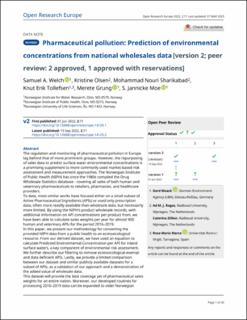| dc.contributor.author | Welch, Samuel Alexander Stafford | |
| dc.contributor.author | Olsen, Kristine | |
| dc.contributor.author | Nouri Sharikabad, Mohammad | |
| dc.contributor.author | Tollefsen, Knut-Erik | |
| dc.contributor.author | Grung, Merete | |
| dc.contributor.author | Moe, Solveig Jannicke | |
| dc.date.accessioned | 2023-03-20T14:21:13Z | |
| dc.date.available | 2023-03-20T14:21:13Z | |
| dc.date.created | 2023-03-01T12:10:50Z | |
| dc.date.issued | 2022 | |
| dc.identifier.citation | Open Research Europe. 2022, 2:71. | en_US |
| dc.identifier.issn | 2732-5121 | |
| dc.identifier.uri | https://hdl.handle.net/11250/3059347 | |
| dc.description.abstract | The regulation and monitoring of pharmaceutical pollution in Europe lag behind that of more prominent groups. However, the repurposing of sales data to predict surface water environmental concentrations is a promising supplement to more commonly used market-based risk assessment and measurement approaches. The Norwegian Institute of Public Health (NIPH) has since the 1980s compiled the Drug Wholesale Statistics database - covering all sales of both human and veterinary pharmaceuticals to retailers, pharmacies, and healthcare providers.
To date, most similar works have focused either on a small subset of Active Pharmaceutical Ingredients (APIs) or used only prescription data, often more readily available than wholesale data, but necessarily more limited. By using the NIPH’s product wholesale records, with additional information on API concentrations per product from, we have been able to calculate sales weights per year for almost 900 human and veterinary APIs for the period 2016–2019.
In this paper, we present our methodology for converting the provided NIPH data from a public health to an ecotoxicological resource. From our derived dataset, we have used an equation to calculate Predicted Environmental Concentration per API for inland surface waters, a key component of environmental risk assessment. We further describe our filtering to remove ecotoxicological-exempt and data deficient APIs. Lastly, we provide a limited comparison between our dataset and similar publicly available datasets for a subset of APIs, as a validation of our approach and a demonstration of the added value of wholesale data.
This dataset will provide the best coverage yet of pharmaceutical sales weights for an entire nation. Moreover, our developed routines for processing 2016–2019 data can be expanded to older Norwegian wholesales data (1974–present). Consequently, our work with this dataset can contribute to narrowing the gap between desk-based predictions of exposure from consumption, and empirical but expensive environmental measurement. | en_US |
| dc.language.iso | eng | en_US |
| dc.rights | Navngivelse 4.0 Internasjonal | * |
| dc.rights.uri | http://creativecommons.org/licenses/by/4.0/deed.no | * |
| dc.title | Pharmaceutical pollution: Prediction of environmental concentrations from national wholesales data | en_US |
| dc.type | Peer reviewed | en_US |
| dc.type | Journal article | en_US |
| dc.description.version | publishedVersion | en_US |
| dc.rights.holder | © 2022 Welch SA et al. | en_US |
| dc.source.pagenumber | 30 | en_US |
| dc.source.volume | 2 | en_US |
| dc.source.journal | Open Research Europe | en_US |
| dc.identifier.doi | 10.12688/openreseurope.14129.2 | |
| dc.identifier.cristin | 2130442 | |
| dc.source.articlenumber | 71 | en_US |
| cristin.ispublished | true | |
| cristin.fulltext | original | |
| cristin.qualitycode | 1 | |

